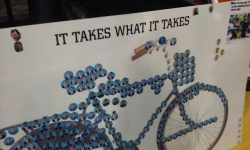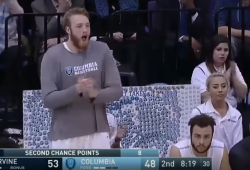Sports editor Ross Chapman is back with more expert basketball analysis. This time, he’s writing about Conor Voss, John Sica, and Peter Barba – three players who started their Columbia basketball legacy on the bench.
Levien Gym, Columbia’s basketball gym of 2,700 fans, loves Conor Voss. The 7’1″ senior center has always been the tallest Lion, but he hasn’t always used that height on the court – Voss logged only 142 minutes in his first three seasons at Columbia. But Voss has made himself a team presence since when he was learning to play the center role from Cory Osetkowski. Even on a slow day at Levien, Voss could always be found jumping and cheering from the bench when a teammate hit an exciting three or rejected an opposing shot. His enthusiasm was infectious. When Voss started to get minutes in nearly every game, the passion he gave was returned by his teammates.
Voss’s evolution from bench character to offensive and defensive threat is impressive, but it happens all the time. Every year, seniors graduate and new players have to step up – in basketball and everywhere else. What those players do, and how they train and perform, determines the future of this Lions squad We talked with Conor Voss, John Sica, and Peter Barba to learn more about this transformation.
Point(er)s from the Bench
“We’re not thinking to ourselves, ‘oh, we’re not going to play,'” explained sophomore forward John Sica. “We’re always competing, and we always know that Coach isn’t afraid to go down the bench.” Sica is a member of the Lions’ “Red Team” in practice, made up of five players who don’t get much time on the court. But they play hard in practice every day because there is always the chance that they’ll be called upon to step up. Kendall Jackson, a senior guard from the team, did just that in Saturday’s win over Penn. His 23 minutes on the court were more than he had played all season combined. He received a starting nod in his final home game in Levien out of respect, and he excelled in the opportunity, scoring the game’s first points and holding off Penn’s perimeter threats. It was Jackson’s biggest role on the team since he came in as a defensive matchup in the CIT semifinals last season.
“I was not surprised at all,” said sophomore guard Peter Barba of Jackson’s performance. “Kenny plays well every day in practice.” But the players see practice as more than just a way to build their own careers up. “We’re trying to help prepare the starters to be ready for the other team,” said Sica. The Red Team plays the role of the “scout team” in practice. “One of our coaches will have us run through a couple of [another team’s] plays, and then we’ll run it live against the starters, so they can get a live look at how the plays are run, rather than just drawing it up on a board.”
While scouting out the opponents can occasionally be cartoonish, it can work wonders to prepare the team against unorthodox plays. And by fully committing themselves to studying the footage of opposing teams running plays, players like Sica and Barba can pick up on intricacies and signals, and relay them to the team. “Remember this one?” Barba turned to Sica and waved his flat hand forward and backward a few inches above his head. “It was one of Penn’s signals that we scouted, and on the bench we were all calling out, ‘Flare screen! Flare screen!'” Barba looked exhilarated thinking back to Saturday. “We see these things, and we can call them to the guys on the court who might not see it.”
Statisticians often track participation from the bench in terms of “bench points,” the number of points scored in a game by players who don’t start the game on the court. But Barba and Sica contribute in more ways than just points. “Even as someone who doesn’t get a lot of minutes,” he said, “we can still have leadership roles in the team – being vocal encouragers during games and pointing out what we see on the bench can really help our teammates.”
Finding a Role
“Everyone can’t be a big scorer.” Sica delivered a basketball cliche, but it rings especially true on a Lions team where Luke Petrasek, Mike Smith, and Nate Hickman account for 57% of the Lions’ scoring offense. “If you’re not that type of player, then you just have to find a role on the team.”
Conor Voss’s first role was handed to him his freshman year. “When I got here, I was really tall,” he said, laughing, “but I was pretty slow, not that strong.” For his first three years, Voss spent most of his time on the court rebounding and blocking by standing in front of the basket and being tall. Unfortunately for Voss, former coach Kyle Smith preferred to go to other players like Cory Osetkowski, Luke Petrasek, and Jeff Coby for his being-tall-related needs. Voss is quick to credit Coach Jim Engles for his success this year. “He gave me those chances to get into the games and to have an impact.” But Voss also improved on his own, especially in his conditioning and quickness. Over time, he has carved out his role as the team’s only true center.
Broadly speaking, a “role player” is anyone whose primary purpose on the court is something other than scoring points. Voss, Sica, and Barber all expressed respect for Isaac Cohen, CC ’16, a quintessential supporting role player. “He was just the best at his role,” recounted Sica. “He helped the team a lot more than a lot of people realize, because he was so good at his role.” As compared to his fellow classmates Alex Rosenberg, Maodo Lo, and Grant Mullins, Cohen scored only 3 points per game in his senior campaign. But he was an exceptional ball-handler, with a 3.4:1 assist:turnover ratio, and Coach Smith often praised him as a coach on the court with incredible hustle. Other role players on the team include Kendall Jackson, an on-the-ball defensive specialist, and Chris McComber, a post-defending forward who matches up with big men better than Luke Petrasek and Jeff Coby.
John Sica wants to carve out that role for himself. He began to describe how he sees his future with the team. “Last year, I was really focused on defense. Coach really focused-”
“Stingy, is his nickname,” interjected Voss in praise, “’cause he got so many steals.” With Lo’s graduation and Petrasek’s impending final games, the team has a spot open for a steal generator, one which Sica hopes to fill. “This year,” Sica continued, “I think I’ve improved a lot in other aspects like shooting… I’m trying to keep working on different aspects of my game.”
According to Voss, everyone takes time finding their role. “In Maodo’s freshman year,” Voss told, “he didn’t play at the beginning very much. And I remember one specific conversation I had with him. He said how he learned what the coaches wanted him to be doing when he was in the game or when he was in practice, and he worked to be as good as he could possibly be at that specific thing. And he said to me, if my thing is, ‘I have to get rebounds,’ or ‘I have to be able to play defense,’ be as good as you can at that one good thing, so that that can be your role, can be your identity, and that’ll earn you your minutes, and I took that to heart a little bit last year. I think that that time has paid off this year.”
The search for a role, as Voss says, is more than just a quest for minutes. Becoming the best at your role secures your identity on the team to the players and to the fans. Voss didn’t just sit on the bench for his first few seasons – he was a bench player, albeit one who carved out his own space as a cheerleader. As Barba and Sica move forward in their careers, they will create identities for themselves, rising from Red Team underclassmen to team leaders.
It Takes What It Takes
Players are also students, and members of the team have to go through the practical full-time job of playing basketball while also keeping up with their courses. It takes a special motivation to go 100% in practice every day. “We all enjoy basketball,” began Sica. “We all love coming to practice, we all love playing.
“And then, we have to do it for the rest of our team, too. We can’t have an off day one day, we can’t not show up to practice, mentally or anything, cause that will hurt the rest of team.” Camaraderie, more than anything, motivates players to leave everything out on the court.
“We spend every day with each other,” said Voss. “Guys on the team are our closest friends, on the court, off the court. So when we step on the court, playing for and with each other and getting a win together, that’s everything. And when you lose, that’s something you go through together.”
Player-focused coaches do all they can to extract and exploit that motivation. In an attempt to quantify and reward “hustle,” former coach Kyle Smith created “The Bike,” a mysterious poster board displaying a bike covered with stickers which resided behind the Lions’ bench in 2016.
“Coach Smith loved to tell stories about things that happened in his past life or in other people’s basketball experiences that motivated them,” recalled Voss, “so he told us this story about this bike that he was given as a child. I think he left it out, in the yard?”
“It got rusty,” confirmed Sica.
“It got rusty, and then his dad sold the bike, like, ‘If you’re not gonna take care of it, you can’t have it.’ So the bike was… you have to take care of the small things, of the team. It takes what it takes to win, you have to do the small things to win. So the stickers were, whenever you did a certain “hustle stat,” they were called… you’d get your sticker put up on the bike.”
As the year went on, the bike on the poster was submerged in a sea of stickers, representing every extra push of effort put forward by Lions.
- The bike in December…
- … and the bike in March
That motto, “It Takes What It Takes,” went on the team’s warmup shirts during the CIT championship game. It applies doubly to bench players, who are expected to make the most out of their limited minutes. In the CIT, it did take what it took. Isaac Cohen notched five assists and stood up to UC Irvine’s 7’6″ center and somehow challenged him on rebounds. Kendall Jackson came in as a role player and hit a momentum-swinging three. Chris McComber came in to control the post against two monstrous centers. Jeff Coby came off the bench to draw eight free throws, and hit them all. It was off of these role and bench performances that Grant Mullins and Luke Petrasek led the team to their first ever tournament championship. Conor Voss, for what it was worth, stood up for nearly the whole second half on the bench, encouraging and shouting at the players on the court.
Next year, as the Lions look to move up in the Ivy League, it’s time for John Sica and Peter Barba to play their roles.
Winning from the bench via Columbia University Athletics/Mike McLaughlin


 0 Comments
0 Comments


